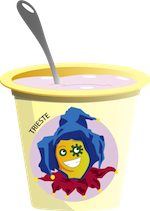Team:Trieste/parts/3
From 2012.igem.org
(Difference between revisions)
| (37 intermediate revisions not shown) | |||
| Line 11: | Line 11: | ||
<h2>Description </h2> | <h2>Description </h2> | ||
This composite produces constitutively the CymR regulator protein, that binds the Cumate Operator repressing the transcription from the promoter. | This composite produces constitutively the CymR regulator protein, that binds the Cumate Operator repressing the transcription from the promoter. | ||
| - | < | + | <br/> |
| - | </br> | + | <center><img src="https://static.igem.org/mediawiki/2012/2/2d/TriesteCymR_orange.jpg" width="500px"/></center> |
| + | <br/> | ||
| + | <br/> | ||
<h2>Assembly</h2> | <h2>Assembly</h2> | ||
| - | </br> | + | The CymR gene was obtained by synthesis and then was assembled with other BioBricks. |
| + | <br/> | ||
| + | <br/> | ||
| + | <center><img src="https://static.igem.org/mediawiki/2012/b/b0/875003.png" width="300px"/></center> | ||
| + | <br/> | ||
| + | <br/> | ||
<h2>Results</h2> | <h2>Results</h2> | ||
CymR expression was confirmed by Western Blot analysis. | CymR expression was confirmed by Western Blot analysis. | ||
Our CymR has a SV5 tag at the C-terminus in order to be detected by an anti-SV5 Ab. | Our CymR has a SV5 tag at the C-terminus in order to be detected by an anti-SV5 Ab. | ||
Its functionality was confirmed through the repression of T5 Cumate Operator-GFP. | Its functionality was confirmed through the repression of T5 Cumate Operator-GFP. | ||
| + | <br/> | ||
| + | <img src="https://static.igem.org/mediawiki/2012/d/d0/Trieste-CymR_V.jpg" width="600px"/> | ||
| + | <br/> | ||
| + | The validation of the repression of the protein CymR on the T5 cumate operator was verified through the creation of a plasmid containing a single copy of CymR and the T5 cumate operator upstream the GFP (I13504). We saw that the expression of the GFP was completely repressed in absence of p-cumate but it was active in presence of p-cumate. | ||
| + | <br/> | ||
| + | <center><img src="https://static.igem.org/mediawiki/igem.org/4/4c/TriesteT5_Cumate_operator_V.jpg" width="500px"/></center> | ||
| + | <br/> | ||
| + | <br/> | ||
| + | <br/> | ||
| + | <div class="notebook_section"> | ||
| + | <h2 class="notebook_title">Post European-Jamboree</h2> | ||
| + | <strong>Cuminaldehyde activation of cumate switch</strong><br/><br/> | ||
| + | We also tested the activity of the cuminaldehyde in the regulation of the cumate switch and we confirmed that it is able to activate the cumate switch, although in higher concentrations.<br/><br/> | ||
| + | <center><img src="https://static.igem.org/mediawiki/2012/0/02/TriesteCuminaldehyde.png" width="300px"/></center> | ||
| + | <br/> | ||
| + | <br/> | ||
| + | <p class="didascalia"><strong>Cuminaldehyde test. </strong>We streaked the <i>E.coli</i> containing the plasmid with J23100-CymR-B0015+T5CumateOperator-I13504(GFP) on LB agar plates at different concentration of cuminaldehyde.</p> | ||
| + | <br/><br/> | ||
| + | </div> | ||
| + | <br/> | ||
| + | <br/> | ||
| + | <h2>Looking forward</h2> | ||
| + | The next step will be the integration of two copies of CymR in the bacterial genome in order to regulate the toxin genes carried by the plasmid. | ||
| + | <br/> | ||
| - | < | + | <br/> |
| - | + | <br/> | |
| - | + | ||
| - | + | ||
| - | < | + | |
| - | + | ||
| - | + | ||
<h3><a href="http://partsregistry.org/Part:BBa_K875003"target="_blank">Link to the Registry</a></h3> | <h3><a href="http://partsregistry.org/Part:BBa_K875003"target="_blank">Link to the Registry</a></h3> | ||
| - | < | + | <br/> |
<!-- ******************** CONTENUTO QUI ****************** --> | <!-- ******************** CONTENUTO QUI ****************** --> | ||
| Line 38: | Line 64: | ||
<li><a href="https://2012.igem.org/Team:Trieste/parts/1">BBa_K875001 - Cumate Op</a></li> | <li><a href="https://2012.igem.org/Team:Trieste/parts/1">BBa_K875001 - Cumate Op</a></li> | ||
<li><a href="https://2012.igem.org/Team:Trieste/parts/2">BBa_K875002 - Lac OP</a></li> | <li><a href="https://2012.igem.org/Team:Trieste/parts/2">BBa_K875002 - Lac OP</a></li> | ||
| - | <li><a href="https://2012.igem.org/Team:Trieste/parts/3">BBa_K875003 - CymR</a></li> | + | <li class="select" ><a href="https://2012.igem.org/Team:Trieste/parts/3">BBa_K875003 - CymR</a></li> |
<li><a href="https://2012.igem.org/Team:Trieste/parts/4">BBa_K875004 - OmpA scFv</a></li> | <li><a href="https://2012.igem.org/Team:Trieste/parts/4">BBa_K875004 - OmpA scFv</a></li> | ||
<li><a href="https://2012.igem.org/Team:Trieste/parts/5">BBa_K875005 - OmpA SIP</a></li> | <li><a href="https://2012.igem.org/Team:Trieste/parts/5">BBa_K875005 - OmpA SIP</a></li> | ||
Latest revision as of 18:24, 26 October 2012
BBa_K875003
More
Description
This composite produces constitutively the CymR regulator protein, that binds the Cumate Operator repressing the transcription from the promoter.
Assembly
The CymR gene was obtained by synthesis and then was assembled with other BioBricks.
Results
CymR expression was confirmed by Western Blot analysis. Our CymR has a SV5 tag at the C-terminus in order to be detected by an anti-SV5 Ab. Its functionality was confirmed through the repression of T5 Cumate Operator-GFP.
The validation of the repression of the protein CymR on the T5 cumate operator was verified through the creation of a plasmid containing a single copy of CymR and the T5 cumate operator upstream the GFP (I13504). We saw that the expression of the GFP was completely repressed in absence of p-cumate but it was active in presence of p-cumate.

Post European-Jamboree
Cuminaldehyde activation of cumate switchWe also tested the activity of the cuminaldehyde in the regulation of the cumate switch and we confirmed that it is able to activate the cumate switch, although in higher concentrations.

Cuminaldehyde test. We streaked the E.coli containing the plasmid with J23100-CymR-B0015+T5CumateOperator-I13504(GFP) on LB agar plates at different concentration of cuminaldehyde.
Looking forward
The next step will be the integration of two copies of CymR in the bacterial genome in order to regulate the toxin genes carried by the plasmid.Link to the Registry







 "
"









